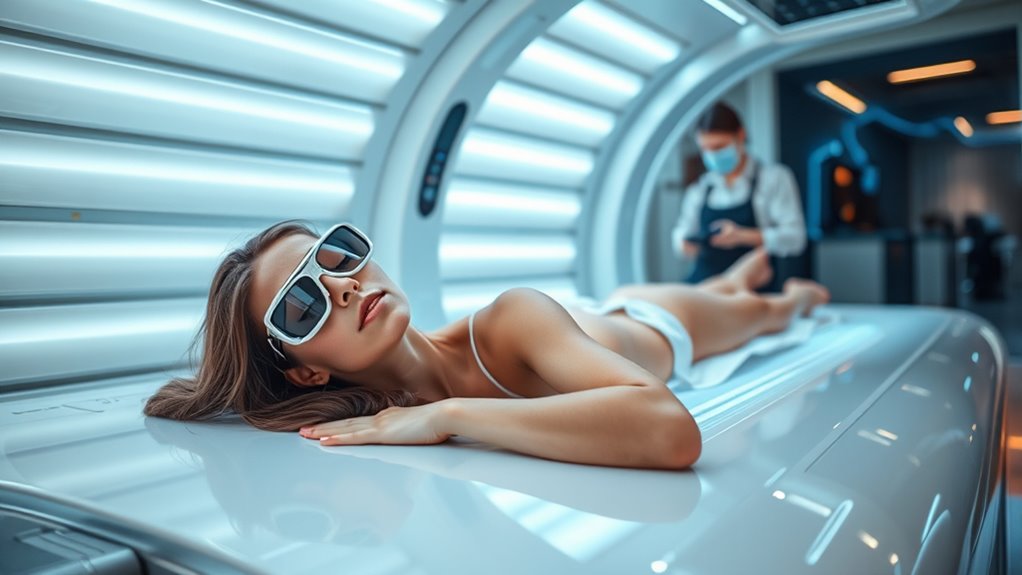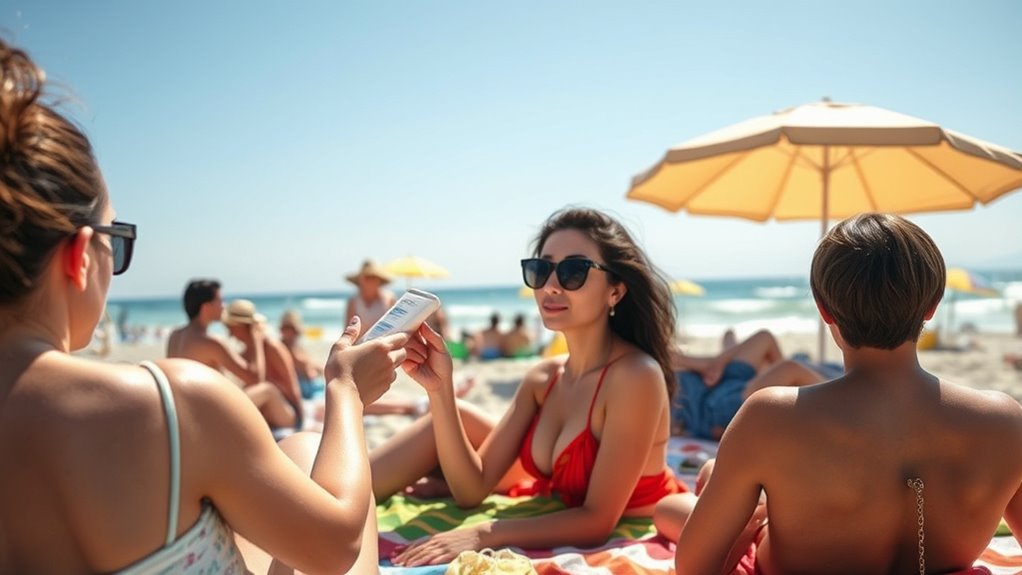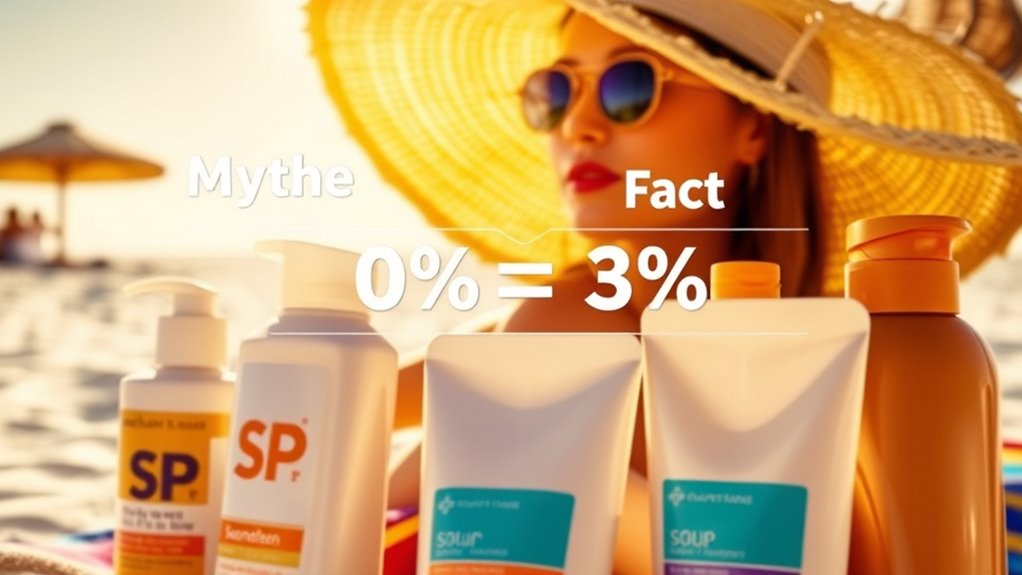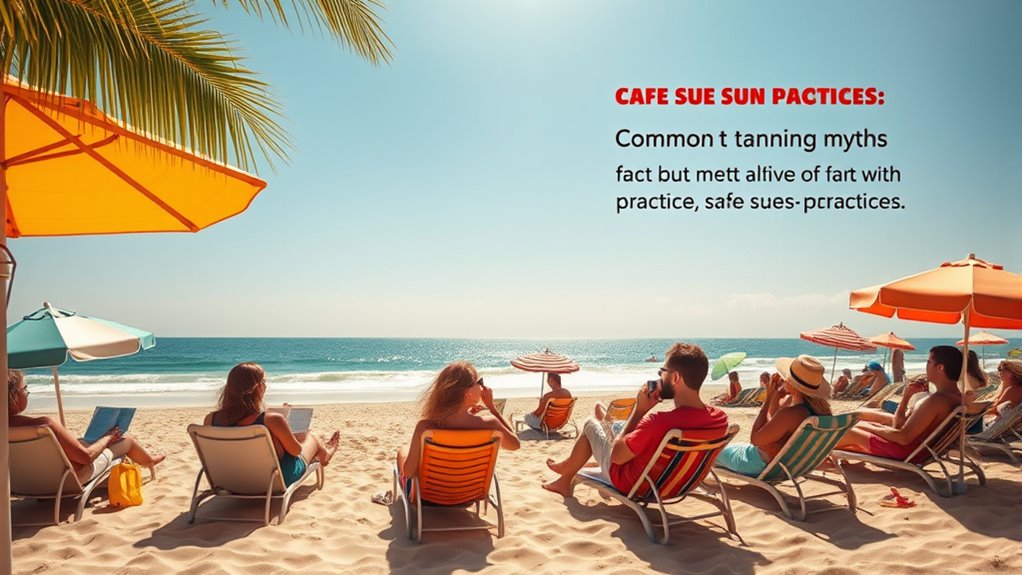Many tanning myths are false and can harm your skin. People often believe that tanning beds are safe or that a base tan protects against sunburn, but both increase skin damage and cancer risk. Some think a “healthy glow” isn’t risky, but UV exposure causes DNA damage, aging, and long-term harm. Understanding the facts helps you protect your skin better. Stick around to discover the truth behind these common misconceptions and how to stay safe.
Key Takeaways
- A base tan offers minimal SPF protection (2-4) and does not prevent skin damage or skin cancer risk.
- Indoor tanning beds emit UVA and UVB rays, increasing melanoma risk, especially when started before age 35.
- Melanin provides some natural UV protection, but all skin types can sustain damage and benefit from proper sun protection.
- A tan indicates skin DNA damage; relying on it for protection is unsafe and increases long-term skin harm.
- Proper sun safety includes broad-spectrum sunscreen, protective clothing, shade, and avoiding tanning beds for skin health.
The Reality of Safe Tanning and Skin Damage

Many people believe that achieving a tan from the sun or tanning beds can be safe, but in reality, any UV exposure damages your skin. UV rays harm your skin’s DNA, increasing the risk of skin cancers like melanoma, basal, and squamous cell carcinoma. They also accelerate aging by breaking down collagen and elastin, leading to wrinkles and leathery skin. Even moderate sun exposure without protection adds oxidative stress, causing further damage. The danger is cumulative—repeated exposure worsens long-term harm. Young people are especially vulnerable. While some think a tan offers protection, it only provides a minimal SPF of 2 to 4, which isn’t enough. So, any tanning from UV sources isn’t safe, and protecting your skin should always be a priority. UV exposure levels can vary widely, but any amount contributes to skin damage over time. Recognizing the long-term effects of UV exposure is essential for making informed decisions about sun safety. In addition, understanding the protective benefits of sunscreen and other sun safety measures can help reduce your risk. Regular use of appropriate sun protection can significantly lower the chances of skin damage and related health issues. Moreover, adopting sun-safe habits such as seeking shade and wearing protective clothing can further reduce harmful UV exposure.
Indoor Tanning: Risks and Misconceptions

Indoor tanning exposes you to UV radiation that can considerably increase your risk of skin cancer and other health problems. Tanning beds emit UVA and UVB rays, sometimes stronger than natural sunlight, damaging your skin and increasing melanoma, basal, and squamous cell carcinomas. If you start tanning before age 35, your melanoma risk jumps by 60%-80%. Many believe tanning beds are safe or healthier than sun exposure, but this is false—no safe alternative exists. UV radiation from tanning beds is classified as carcinogenic by the WHO, and it can cause cataracts and premature skin aging, too. Despite regulations in some places, many still use tanning beds, unaware of the serious health risks involved. The dangers far outweigh any perceived benefits, so it’s best to avoid indoor tanning altogether. Dog names are often chosen to reflect a pet’s personality or appearance, but they should be easy to call and remember, just like choosing a name for a dog.
The Truth About Base Tans and Sunburn Prevention

A base tan offers only minimal protection against UV rays, providing roughly the same defense as sunscreen with an SPF of about 3 or less. This means it slightly extends the time before your skin burns, but not enough to rely on for safety. Typical sunscreens with SPF 15 to 30 are far more effective. While a base tan might allow you to stay in the sun up to four times longer before burning, it doesn’t prevent damage entirely. UV exposure from trying to develop a base tan still causes cumulative skin harm, increasing risks of skin cancer, wrinkles, and spots. Many people mistakenly believe a base tan prevents sunburn, leading to risky behavior. To protect your skin, use high-SPF sunscreen, wear protective clothing, and seek shade—don’t depend on a tan for safety. Understanding sun protection is crucial for maintaining healthy skin and reducing long-term damage. Recognizing that a base tan provides only a false sense of security can help you make safer choices in sun exposure. Additionally, sun damage accumulates over time, further emphasizing the importance of proper protection from the outset. Moreover, awareness of AI ethicist jobs and related roles highlights the importance of ethical considerations in technological advancements, including those impacting health and safety practices.
Vitamin D and Tanning: What You Need to Know

Have you ever wondered how tanning affects your body’s ability to produce vitamin D? UVB light from the sun or tanning beds triggers vitamin D synthesis in your skin. Regular UVB exposure can raise your vitamin D levels to healthy, physiological ranges. However, tanning can also darken your skin by increasing melanin, which blocks UVB rays, reducing vitamin D production, especially in darker skin tones. Tanning beds emitting UVB can boost vitamin D levels effectively, but risks like skin cancer outweigh the benefits. Natural sunlight remains the safest source, and supplements or dietary options are good alternatives. Remember, while UV exposure can help, balancing your sun habits is key to maintaining adequate vitamin D without risking skin damage. Monitoring your skin’s response and understanding the effects of melanin can help you make informed decisions about safe sun exposure. Additionally, understanding how installation guidelines for sun protection and skin health can further support your well-being. To optimize your vitamin D levels safely, consider incorporating Glycolic Acid into your skincare routine to improve skin texture and health, which can also enhance your natural glow. Recognizing the importance of skin types and their responses to UV exposure can help tailor your tanning habits for better health outcomes. Furthermore, certain bike conversion kits highlight the importance of proper installation and maintenance to ensure safety and optimal performance.
Tanning and Skin Color: Protecting All Skin Types

Since melanin naturally provides some protection against UV rays, your skin’s color influences how much damage exposure can cause. Darker skin has more baseline melanin, offering higher natural protection, but it’s not immune to UV damage. Tanning increases melanin, but only provides an SPF of about 2 to 4, which isn’t enough to prevent harm. All skin types, from fair to deep, can tan and darken within 48 hours after UV exposure, indicating DNA damage. Even darker skin tones face risks like skin cancer, especially in less pigmented areas or with indoor tanning. Remember, no skin type can safely tan. Tanning signals skin damage, and relying on a base tan or tanning beds heightens the risk of long-term harm. Proper sun protection is essential for everyone. Understanding skin responses can help you better protect yourself from UV-related damage. Additionally, protective measures such as wearing sunscreen and seeking shade are crucial regardless of skin tone.
SPF Ratings: Understanding Their Effectiveness

SPF ratings primarily measure how well a sunscreen protects against UVB rays, which cause sunburn and contribute to skin cancer. For example, SPF 30 blocks about 97% of UVB rays, while SPF 50 blocks around 98%, showing diminishing returns at higher levels. Higher SPF allows less UVB penetration but doesn’t block all UVB rays; SPF 50 still lets in about 2%. The SPF number indicates how much longer you can stay in the sun without burning compared to no protection. Remember, applying sunscreen correctly—15 to 30 minutes before sun exposure and reapplying every two hours—is essential. Proper application techniques like layering and manipulation can be compared to applying multiple layers of sunscreen to achieve optimal protection. Keep in mind, SPF doesn’t measure UVA protection, so choose broad-spectrum formulas that shield against both UVA and UVB rays for complete skin safety. To maximize your protection, understanding merchant services can help you choose the right sunscreen products and purchase them securely online. Additionally, selecting sunscreens with broad-spectrum protection ensures comprehensive defense against the full spectrum of harmful rays. Embracing creative practice by exploring different formulations and application methods can also enhance your sunscreen routine and skin safety.
The Dangers of UV Radiation From All Sources

UV radiation comes from multiple sources, not just sunlight, and understanding these sources is essential for protecting your skin. UVA rays penetrate deep, contributing to premature aging and skin cancer, while UVB rays cause sunburns and are a major cancer risk. UVC radiation is absorbed by the ozone layer but can be harmful if emitted artificially, such as from germicidal lights. Reflective surfaces like water, sand, and snow can bounce UV rays and increase your exposure, even on cloudy days. Besides sunlight, tanning beds emit UV similar to the sun, raising your risk, and some artificial lights can emit UV too. Being aware of these sources helps you take better precautions—wear protective clothing, apply sunscreen, and avoid peak hours to reduce your UV exposure and protect your health. Additionally, certain tanning devices can emit concentrated UV radiation, further increasing the risk of skin damage and cancer.
How Skin Ages and the Impact of Tanning

Skin aging results from a combination of natural processes and environmental factors, with tanning playing a significant role in accelerating the decline. When you expose your skin to UV rays, it damages collagen and elastin fibers, which are essential for skin strength and elasticity. This breakdown leads to wrinkles, sagging, and increased skin fragility. Tanning also causes uneven pigmentation and age spots by disrupting melanocyte activity. Over time, UV damage weakens the connection between the epidermis and dermis, resulting in thinner, more translucent skin. Chronic exposure accelerates DNA mutations and oxidative stress, raising your risk of skin cancer. The cumulative effect of tanning not only worsens visible signs of aging but also diminishes your skin’s ability to repair itself, making it more vulnerable to environmental damage.
Best Practices for Sun Safety and Skin Health

Protecting your skin from sun damage requires more than just avoiding tanning beds or excessive exposure. You should apply broad-spectrum sunscreen with SPF 15 or higher generously—about one ounce—15 minutes before going outside. Reapply every two hours, even on cloudy days, and after swimming or sweating. Wear protective clothing like long sleeves, wide-brimmed hats, and UV-blocking sunglasses, especially during peak hours from 10 a.m. to 4 p.m. Seek shade and plan outdoor activities early or late in the day to minimize UV exposure. Avoid intentional tanning and tanning beds, as they increase skin cancer risk. For vitamin D, rely on diet and supplements instead of sun exposure. By following these practices, you help preserve your skin’s health and reduce damage.
Frequently Asked Questions
Can Tanning Beds Be Completely Safe for Your Skin?
You might wonder if tanning beds can be completely safe for your skin. The truth is, they’re not safe at all. Using tanning beds exposes you to high-intensity UV radiation that damages your DNA, increasing your risk of skin cancer, including melanoma. Even a single session can cause harm, especially if you start young. It’s best to avoid tanning beds and protect your skin by staying in the shade or using sunscreen.
Is It Possible to Get Enough Vitamin D Without Any Sun Exposure?
You wonder if you can get enough vitamin D without sun exposure, and yes, you can. You can rely on fortified foods like milk alternatives and cereals, consume fatty fish or take cod liver oil supplements, and include mushrooms exposed to sunlight in your diet. You might also consider vitamin D3 supplements, especially if your diet isn’t sufficient. Regular check-ups help guarantee your levels stay ideal without risking skin damage.
Are There Any Skin Tones That Don’t Need Sun Protection?
You might wonder if certain skin tones don’t need sun protection. The truth is, all skin tones, from very light to very dark, need protection. Melanin provides some natural defense, but it’s not enough to prevent UV damage, skin aging, or cancer. So, you should use sunscreen daily, wear protective clothing, and seek shade, regardless of your skin color. Sun safety is essential for everyone.
How Often Should I Reapply Sunscreen During Outdoor Activities?
During outdoor activities, you should reapply sunscreen every two hours as a general rule. If you’re swimming, sweating heavily, towel drying, or in high UV conditions, reapply more often—about every 40 to 80 minutes. Keep in mind, water-resistant sunscreens still need reapplication after water exposure. Also, check UV levels and reapply accordingly to guarantee continuous protection and safeguard your skin from damage.
Can a “Base Tan” Really Help Prevent Sunburns?
Think of a “base tan” like a tiny, weak shield—barely enough to block a breeze. It offers only minimal sunburn protection, similar to SPF 3-4, far below the recommended SPF 15. Relying on it is risky; UV rays still cause skin damage and increase cancer risk. Instead, use broad-spectrum sunscreen, protective clothing, and seek shade for real protection—your skin deserves better than a flimsy disguise.
Conclusion
Now that you’ve uncovered the truth behind tanning myths, it’s clear that the risks outweigh the rewards. Don’t fall for the old tricks—protect your skin like a hawk and prioritize your health over fleeting tans. Remember, the devil is in the details; staying informed is your best defense. When it comes to tanning, it’s better to be safe than sorry—after all, a little caution goes a long way in keeping your skin youthful and vibrant.









